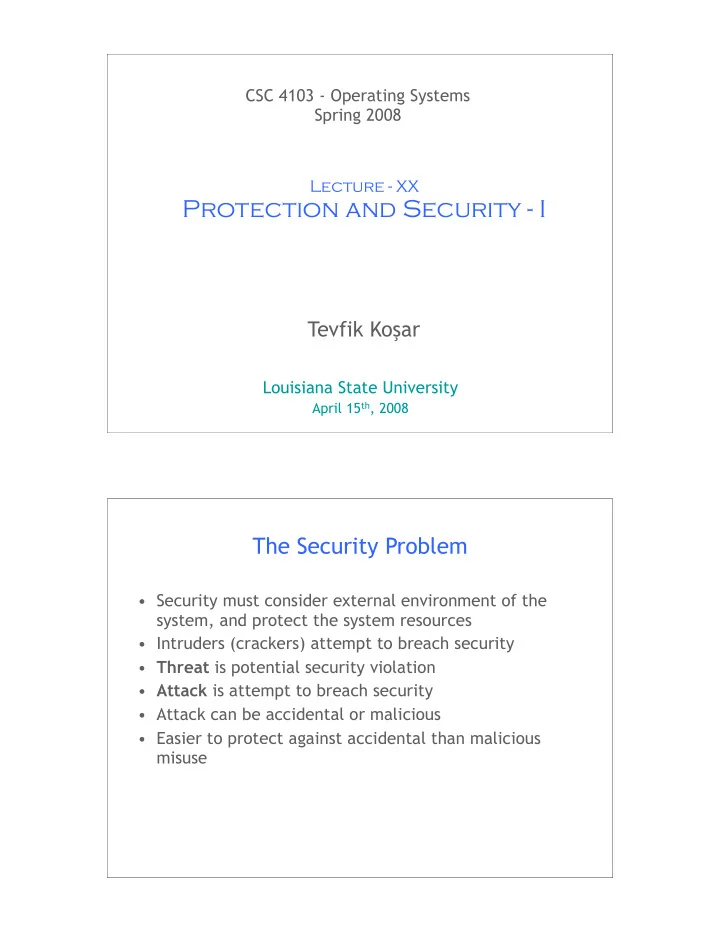

CSC 4103 - Operating Systems Spring 2008 Lecture - XX Protection and Security - I Tevfik Ko � ar Louisiana State University April 15 th , 2008 1 The Security Problem • Security must consider external environment of the system, and protect the system resources • Intruders (crackers) attempt to breach security • Threat is potential security violation • Attack is attempt to breach security • Attack can be accidental or malicious • Easier to protect against accidental than malicious misuse
Security Violations • Categories – Breach of confidentiality (information theft, identity theft) – Breach of integrity (unauthorized modification of data) – Breach of availability (unauthorized destruction of data ) – Theft of service (unauthorized use of resources) – Denial of service (crashing web servers) • Methods – Masquerading (breach authentication) • Pretending to be somebody else – Replay attack (message modification) • Repeating a valid data transmission (eg. Money transfer) • May include message modification – Session hijacking • The act of intercepting an active communication session – Man-in-the-middle attack • Masquerading both sender and receiver by intercepting messages Standard Security Attacks
Secure Communication over Insecure Medium Encryption • Encryption algorithm consists of – Set of K keys – Set of M Messages – Set of C ciphertexts (encrypted messages) – A function E : K � ( M � C ). That is, for each k � K , E ( k ) is a function for generating ciphertexts from messages. – A function D : K � ( C � M ). That is, for each k � K , D ( k ) is a function for generating messages from ciphertexts. –
Encryption • An encryption algorithm must provide this essential property: Given a ciphertext c � C , a computer can compute m such that E ( k )( m ) = c only if it possesses D ( k ). – Thus, a computer holding D ( k ) can decrypt ciphertexts to the plaintexts used to produce them, but a computer not holding D ( k ) cannot decrypt ciphertexts. – Since ciphertexts are generally exposed (for example, sent on the network), it is important that it be infeasible to derive D ( k ) from the ciphertexts Symmetric Encryption • Same key used to encrypt and decrypt – E ( k ) can be derived from D ( k ), and vice versa • DES is most commonly used symmetric block-encryption algorithm (created by US Govt) – Encrypts a block of data at a time (64 bit messages, with 56 bit key) • Triple-DES considered more secure (repeat DES three times with three different keys) • Advanced Encryption Standard ( AES ) replaces DES – Key length upto 256 bits, working on 128 bit blocks • RC4 is most common symmetric stream cipher (works on bits, not blocks), but known to have vulnerabilities – Encrypts/decrypts a stream of bytes (i.e wireless transmission, web browsers) – Key is a input to psuedo-random-bit generator • Generates an infinite keystream
Asymmetric Encryption • Encryption and decryption keys are different • Public-key encryption based on each user having two keys: – public key – published key used to encrypt data – private key – key known only to individual user used to decrypt data • Must be an encryption scheme that can be made public without making it easy to figure out the decryption scheme – Most common is RSA (Rivest, Shamir, Adleman) block cipher Encryption and Decryption using RSA Asymmetric Cryptography
Asymmetric Encryption (Cont.) • Formally, it is computationally infeasible to derive D ( k d , N ) from E ( k e , N ), and so E ( k e , N ) need not be kept secret and can be widely disseminated – E ( k e , N ) (or just k e ) is the public key – D ( k d , N ) (or just k d ) is the private key – N is the product of two large, randomly chosen prime numbers p and q (for example, p and q are 512 bits each) – Select k e and k d , where k e satisfies k e k d mod ( p � 1)( q � 1) = 1 – Encryption algorithm is E ( k e , N )( m ) = m ke mod N , – Decryption algorithm is then D ( k d , N )( c ) = c kd mod N Asymmetric Encryption Example • For example. choose p = 7 and q = 13 • We then calculate N = 7 ! 13 = 91 and ( p � 1)( q � 1) = 72 We next select k e relatively prime to 72 and < 72, yielding 5 • Finally,we calculate k d such that k e k d mod 72 = 1, yielding 29 • • We how have our keys Public key, k e, N = 5 , 91 – Private key, k d , N = 29 , 91 – • Encrypting the message 69 with the public key results in the cyphertext 62 (E=69 5 mod 91) • Cyphertext can be decoded with the private key – Public key can be distributed in cleartext to anyone who wants to communicate with holder of public key
Cryptography (Cont.) • Note symmetric cryptography based on transformations, asymmetric based on mathematical functions – Asymmetric much more compute intensive – Typically not used for bulk data encryption – Used for authentication, confidentiality, key distribution
Recommend
More recommend